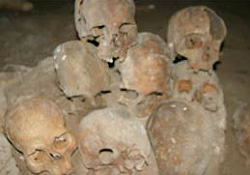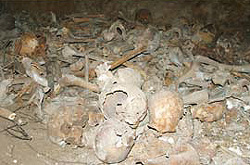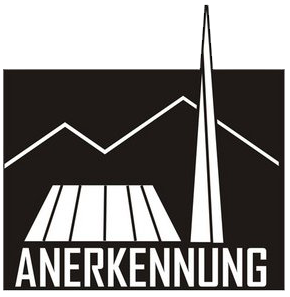Am 7. Dezember 2006 berichteten wir über ein beim Dorf Kuru (nahe Mardin) in einer Höhle gefundenes Massengrab mit Schädeln und Knochen, von denen zu vermuten war, dass es sich um die Überreste massakrierter Armenier und Aramäer/Chaldäer handelt. Der Vorsitzende der Türkischen Historikergesellschaft und oberste Wächter der offiziellen Geschichtslehre, Dr. Yusuf Halacoğlu, schaltete sich jedoch bald mit der Behauptung ein, es handele sich um weit ältere Knochen aus der Römerzeit. Prof. Davit Gaunt vom schwedischen Södertörns University College schlug daraufhin eine gemeinsame Erforschung der Fundstätte vor. Für solche Untersuchungen gibt es international erprobte kriminalistische Regeln, deren oberste lautet, dass nur eine unberührte, also weder absichtlich manipulierte, noch unabsichtlich „verschmutztes“ Fundstätte bzw. Tatort sinnvoll erforscht werden kann. Als Prof. Gaunt am 23. April 2007 feststellen musste, dass offensichtlich die Höhle bei Kuru entsprechend der Römer-These Halacoğlus präpariert worden war, ließ er die internationale Untersuchung abbrechen. Wir veröffentlichen mit Prof. Gaunts Genehmigung eine frühere Presseerklärung sowie seinen Brief vom 26. April 2007 an die Teilnehmer der Turkish-Armenian Weblist…


Press release: Mardin Mass Graves Revisited
February 12, 2006
David Gaunt
In the autumn of 2006 villagers in Kuru (previously known as Harabe Baba) between Mardin and Nusaybin discovered a mass grave in a cave. They identified the victims as “Armenians from 1915” and added that they had found similar mass graves previously. A few photographs were taken and Ülkede Özgür Gündem wrote an article as did the journal Nokta. Both interviewed me on my opinion as I had written a book about massacres in this region. I suggested that the mass grave might be that of the victims of one of several massacres documented by contemporaries. There was documentation of killings of people taken from nearby Dara, Nusaybin, and Mardin as well as of the last remnants of a deportation column that had started in Erzurum. The sparsely settled area where the mass grave had been discovered is on the line of ancient defence works and underground storage rooms dating back to Roman times. It was turned into a killing field during the summer of 1915. With great probability the cave should contain Armenian, but with some likelihood also Assyrian-Syrian and Khaldean, victims. But only a site investigation could tell.
After the first news was spread, authorities cordoned off the cave and only some government agencies had access. Finally in December the site was closed off and the opening was buried. The head of the Turkish Historical Society (TKK), Professor Yusuf Halaçoglu challenged my suggestions and insisted that the bodies found were from Roman times. Thereafter he made many statements to the press challenging a Swedish delegation to investigate the site. This intensified after a debate in the Swedish parliament on December 12, 2006, which was based on reports in Turkish press (not upon my initiative, as some mistakenly believe).
In mid January 2007, I sent up a trial balloon to see if there was any substance to the TKK statements and I proposed to start negotiations on making a joint investigation. It was apparent that the only way any independent scientist would have to study the grave was through some sort of collaboration with the TKK. I am fully acquainted with its abysmal track record on the Armenian-Turkish issues and was, and still am, very hesitant. We had not progressed further than discussing the possible dates for an initial planning meeting, when Hrant Dink was assassinated. I immediately put these negotiations on ice. Apparently, however, the TTK is very hot to pursue this matter and today has gone to Hürriyet revealing the very small amount of progress we had up until the assassination and making some further provocative and totally inappropriate statements.
This investigation of the mass grave must be seriously planned. If the TTK wants to rush in and do an incomplete job in a hurry, there will be no reason for me to continue negotiations. For the sake of legitimacy alone, the TTK cannot expect to do the investigation all by itself and use the independent researchers only for PR-purposes in attempts to influence public opinion. Today I sent the following letter to Dr. Halaçoglu and proposed again a date for a meeting in Mardin. I envision a long scientific investigation with international co-operation. This first meeting can only begin the process of identifying the long lost victims in that mass grave.
Brief an Yusuf Halacoğlu
Türk Tarih Kurumu
Ankara, Turkey
Dear Prof. Halacoğlu,
Many thanks for your letter of January 17 to which I have not until now had opportunity to answer. I am sure that you realize that the assassination of Hrant Dink on January 19 made the situation for discussions about the mass grave difficult and most of our colleagues, including myself suddenly had many other things on our minds.
I was somewhat surprised to see from today’s Hürriyet and even from the TTK homepage last Friday, that you have begun to give information to the press even though we had only just started the preliminaries in what must be a long scientific investigation. I suggested a date for a meeting in Mardin to take the first steps and to make the first look at the mass grave. Unfortuately, these dates did not fit into your schedule, and you suggested some alternative dates. These proved impossible for me because of my teaching burden and prior engagements. May I propose a meeting in Mardin on 23-25 April?
What we still need to discuss are very heavy and difficult issues such as the budget, the size, qualifications and composition of the investigation team, the co-operation of local universities for offices and for adequate storage of the remains during the investigation, the organization for the search for DNA among people whose ancestors might be in the grave. Perhaps I overstate my position, but for clarity it will be impossible for us to call this a joint effort, and it risks the legitimacy of the whole enterprise, if the TTK takes on all responsibility for the investigative work and the independent researchers are kept at arms length, until there is a press conference.
To my pleasure, I see that we are agreed that there should be complete media transparency. While I am on the subject of transparency, please correct me if I am wrong, but I have reason to believe that there have been several Turkish government delegations that have already inspected the grave. You made statements yourself, so I assume the TTK participated. It would be very useful for our common planning if you could send over copies of whatever material there is in whatever form, which has already been assembled. I would take this as a sign of good collegial relations between professional historians who are about to begin a joint venture and, of course, it would greatly speed up the process of negotiations.
The Hürriyet article does contain a misunderstanding. I did not take any initiative to the Swedish parliament discussion of the mass grave. But some of the parliamentarians did read articles in the Turkish press in which I was interviewed and they used that information. I am sure you know that only a member of parliament can introduce a debate.
I see from the Hürriyet article that you have publicly offered to apologize to me in case your conviction about the mass grave is proved wrong. Please, you do not need to do this for me and I don’t understand the necessity of your odd promise, which seems more suited for film-version samurai warriors than down-to-earth researchers. In scientific circles we are daily confronted with new interpretations, new facts, new materials, new techniques and unexpected results – and as scientists we learn from them and are not embarrassed by new knowledge. As fellow historians, I believe that our first priority must be to pay our respect to the past and honour the memory by identifying whoever is enclosed in these long lost graves whatever ethnicity they happen to have had.
Stockholm 2007-02-12
David Gaunt, Professor of History
Södertörns University College
SE-14189 Huddinge
SWEDEN
Brief an die Turkish-Armenian Weblist
26. April 2007
Dear All
As you know by now I was at the mass-grave sıte on Aprıl 23 wıth Yusuf Halacoglu the presıdent of the Turkısh Hıstorıcal Socıety. For me thıs was a pılot case for the degree to whıch ıt was possıble to do an ınternatıonal co-operatıon on a strıctly scıentıfıc no-nonsense basıs.
We were to make a prelımınary survey of the grave ın Kuru vıllage, Nusaybın dıstrıct, Mardın provınce, ın order to see ıf a later scıentıfıc ınvestıgatıon could be made by archaeologısts, forensıc medıcal experts, physıcal anthropologısts, hıstorıans and others. My role was sımply to determıne ıf thıs was a suıtable sıte for a full-scale ınterdıscıplınary research. The fırst task was to determıne ıf the fındıngs were ıntact accordıng to the photographs publıshed ın October and November 2006 – whıch I had wıth me. I had asked also for the archaeologıcal report from the Mardın museum that was dated December 1, 2006 but was not gıven because ıt would cause „complıcatıons“. I dıd get thıs report on the day after the vısıt to the grave.
Based on newspaper artıcles I expected to see the remaıns of 38 persons lyıng more or less on a pıle on top of the floor of a cave wıth masses of skulls, fragments of skulls, leg bones and so on. The skulls were not blackened. Analysıs of the photos had been done by forensıc medıcal experts and they saıd ıt ındıcated that someone had been arrangıng the skulls for the photos, so we already expected a certaın degree of contamınatıon to the sıte.
But I was thouroughly unprepared to dıscover that there were no skulls, skull fragments or large leg bones lyıng vısıble. To one sıde there were some very blackened rıb-bones and few large pıeces of Roman perıod pottery. When I protested, showed the photos, the Turkısh sıde argued that ıt had been raınıng hard durıng the wınter and maybe all of the bones had been covered ın mud and that we could begın dıggıng to fınd them. Thıs ın ıtself was an admıssıon that the sıte was heavıly contamınated sınce ıt meant that the openıng had been left uncovered and unprotected. But why should the Roman pottery be lying neatly and cleanly exposed whıle all of the major bones had sunk ınto the mud. (I had prevıously heard from many sources lıvıng ın many countrıes that the bones had been removed at an early stage – obvıously before the Mardın museum report of December 1. But I had belıeved that they would have been transported back for the sake of our scıentıfıc ınvestıgatıon.) I refused outrıght to do anythıng more ın the grave sıte and left whıle professor Halacoglu made a statement ın the pourıng raın for the medıum sıze press group that was assembled there.
Thıs was a very dısappoıntıng result of an attempt to do some serıous scıentıfıc work. The Physıcıans for Human Rıghts had agreed to do the forensıc medıcal ınvestıgatıon and the Instıtute for Hıstorıcal Justıce and Reconcıllıatıon was to assıst ın the hıstorıcal documentatıon. My task was to gıve a green lıght for a later full scale ınvestıgatıon wıth all necessary permıts. I had to report back that thıs sıte was too contamınated, but there mıght of course be some evıdence remaınıg for a paınstakıng undertakıng.
I have not broken off dıalogue wıth the Turkısh HIstorıcal Socıety because of the grave fıasco as there are other serıously scıentıfıc thıngs that we found worthwhıle dıscussıng. Only tıme wıll tell ıf thıs ınıtıatıve ıs more fruıtful.
Sıncerely yours
Davıd Gaunt
